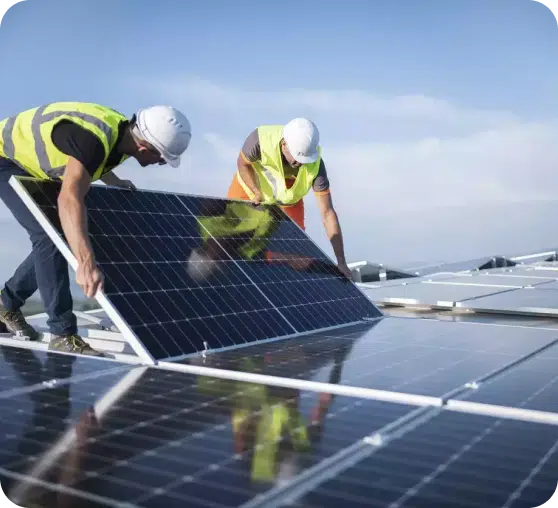Residential Solar
Systems in Victoria
Harness the power of the sun to fuel your home. Let Eco Assets Manager make your transition to solar energy seamless and efficient.
Say goodbye to high electricity bills and hello to a brighter, greener future. Get a personalized quote today!
AM I ELIGIBLE ?
Solar Panel (PV) Rebate - Up to $1,400
Claim Solar Rebate Scheme
As a Victorian Householder, you could be eligible to receive a solar panel (PV) rebate if:
» you are the owner-occupier of an existing property or the owner of a home under construction where the system is to be installed
» the combined household taxable income of all owners is less than $210,000 per year
» the property is valued at under $3 million, or a home under construction that will be valued at under $3 million at the time of completion.
» the property address has not previously recieved a solar panel (PV) rebate under the solar homes program.
» the property has not had a solar panel (PV) system installed in the last ten years.
+ FEDERAL STC INCENTIVE
+ FEED IN TARIFFS
+ STATE GOVERNMENT REBATES
Check out our Ready to go Solar Packages
6.6kW
For Small Family

$0* Upfront
Payment Available

CEC Approved
Panels & Inverter
Output
8,000
(kwh/ Year)
Savings Upto
$1,400
Per Year
9.8kW
For Medium / Large Family

$0* Upfront
Payment Available

CEC Approved
Panels & Inverter
Output
15,000
(kwh/ Year)
Savings Upto
$1,800
Per Year
13.2kW
For Large Family & Small Business

$0* Upfront
Payment Available

CEC Approved
Panels & Inverter
Output
18,000
(kwh/ Year)
Savings Upto
$2,200
Per Year
Solar Energy Grid Solutions

Grid-Connected Systems
In a grid-connected solar system, your connection to the electrical grid remains intact, allowing you to access energy from your utility provider when your solar panels are not producing electricity. These systems are equipped with intelligent inverters that prioritise the use of solar-generated power before resorting to grid electricity. Additionally, grid-connected systems offer the opportunity to sell excess energy back to the grid, providing potential financial benefits to homeowners.

Off-Grid Systems
Off-grid solar systems operate independently, relying on solar batteries to store surplus energy for later use. These systems are designed to provide power without any reliance on the electrical grid. They offer a self-sustaining energy solution, making them particularly suitable for remote or rural areas where establishing a new grid connection can be costly and environmentally less favorable. Off-grid systems ensure that you have a continuous power supply, even in areas without access to the traditional grid infrastructure.

Hybrid Systems
Hybrid solar systems blend grid-connected benefits with solar battery storage. In these setups, solar panels generate electricity during the day, and any excess energy is stored in solar batteries for later use, particularly during periods when solar generation is minimal or at night. One standout feature of hybrid systems is their ability to serve as a backup power source during blackouts or grid failures. When the grid goes down, the stored energy in the batteries can automatically kick in, ensuring that your essential appliances continue to operate seamlessly.
Eco Assets Manager – Residential Energification
A residential solar system consists of three primary components: solar panels with mounting frames, a solar inverter, and the essential cables, switches, and monitoring equipment. For those seeking total energy independence and opting for an "off-grid" solution, the inclusion of a solar battery becomes necessary. One of the remarkable features of solar systems is their modularity, allowing for upgrades at various stages to align with your evolving power needs. It's important to note that different states in Australia offer various incentives and programs to encourage solar adoption. Rest assured, the Eco Assets Manager team possesses comprehensive information and expert advice to guide you seamlessly along your solar journey.
EAM Product Catalogue
At Eco Assets Manager, we proudly install a range of high-quality solar panels, inverters, batteries, hot water heat pumps, air conditioners and EV chargers from reputable brands. Some of the distinguished names we partner with include QCell, SolarEdge, PowerPlus, Emerald, Istore and SunPower.







- Access top brands for a tailored, high-quality energy installation
- Since 2017, we've purchased and partnered with the best products in the industry
Government Financial Incentives
To Help You Upgrade
At Eco Assets Manager, we’re here to guide you through the process of leveraging these government programs and incentives. We’ll help you make the switch to a heat pump system, reducing your energy consumption, minimising your environmental impact, and maximising your savings.
Join us in creating a more sustainable future for Victoria while enjoying the benefits of efficient and eco-conscious water heating.

Solar Homes Program (Victoria) Rebate
You can receive a rebate of up to $1,400 towards the cost of your solar panel installation. The Victorian Solar Homes Program, valued at $1.3 billion, aims to make renewable energy more accessible to Victorian households by offering substantial rebates and interest-free loans for the installation of energy-efficient systems, including solar panels and hot water systems.

Solar Homes Program (Victoria) Interest-Free Loan
Additionally, an interest-free loan of up to $1,400 is available to help cover the remaining costs of your solar system. The loan is repaid over a period of four years. This program not only encourages the adoption of solar energy but also eases the financial burden through rebates and interest-free loans, making sustainable energy solutions more accessible to Victorian homeowners.

Small Scale Technology Certificates (STC’s)
Small Scale Technology Certificates (STCs) offer significant benefits to residential solar buyers in Australia, when working with approved solar retailers like Eco Assets Manager. STCs represent a financial incentive that can substantially reduce the upfront cost of installing a residential solar system.
New Energy Tech Approved Solar Retailer
Australian Energy Upgrades proudly holds accreditation as a New Energy Tech Approved Seller, a distinction that sets us apart in the industry. The New Energy Tech Approved Seller, serving as the authoritative body overseeing the standards of solar installations in Australia, rigorously accredits only those who meet stringent qualifications and consistently deliver excellence. Our Approved Seller status empowers us to advocate for government rebates and incentives, including Small-scale Technology Certificates (STCs) and advantageous feed-in tariffs on your behalf. To qualify for STCs, which significantly reduce the initial cost of solar installation, it’s imperative that your system is designed and installed by a New Energy Tech Approved Seller – and that’s us!
For additional insights into New Energy Tech and the significance of approved sellers and retailers, please visit their website. Click Here
DEDICATED TO HIGH STANDARDS & SUSTAINABILITY

When it comes to delving into the world of renewable energy and liberating yourself from the burden of energy bills, look no further than Eco Assets Manager. We are seasoned experts in solar solutions, catering to both residential and commercial needs.

Roof Type Matters
Assessing your roof’s type, condition, and orientation is paramount. The roof should be structurally sound and able to support the weight of solar panels. Additionally, the roof’s material (e.g., asphalt shingles, metal, or tile) can influence the installation process and costs. A thorough inspection by a solar professional will help determine if any repairs or reinforcements are needed.

Embrace the Sun, Avoid the Shade
Shading can significantly impact the efficiency of your solar panels. Identify potential sources of shading, such as nearby trees, buildings, or structures, and assess their impact on sunlight exposure throughout the day. To mitigate shading issues, consider tree trimming or selecting advanced technologies like micro-inverters or power optimizers, which can enhance panel performance in partially shaded areas.

In The North
The orientation of your solar panels, often referred to as their azimuth, plays a pivotal role in energy production. In the Southern Hemisphere (like Australia), solar panels ideally face north to capture the maximum amount of sunlight throughout the day. However, east or west orientations may also be suitable depending on your energy consumption patterns and available roof space. A professional solar installer can help determine the optimal panel placement for your specific location and energy goals.
Eco Assets Manager is dedicated to providing a seamless and customer-focused process for residential solar sales and installation. Our approach ensures that you receive a high-quality solar system that meets your unique energy needs. Here’s an overview of our residential solar sales and installation process:
STEP 01
STEP 02
STEP 03
STEP 04
Whether you’re embarking on your solar journey, seeking to enhance your current solar setup with cutting-edge storage batteries, or considering the installation of an electric vehicle (EV) charger, you can trust us to provide comprehensive solutions that align with your sustainability goals. Here’s how we can assist:

Check out the services we offer
Whether you’re embarking on your solar journey, seeking to enhance your current solar setup with cutting-edge storage batteries, or considering the installation of an electric vehicle (EV) charger, you can trust us to provide comprehensive solutions that align with your sustainability goals. Here’s how we can assist:
The government makes solar power more affordable through solar rebates in Victoria; covering up to $1,400 off your total system cost along with the current incentives. For more information about SolarVic click here

Frequently Asked Questions
Many factors influence this calculation –
- The cost of electricity
- Level of feed-in tariffs
- Size of your system
- The amount of the sunshine available throughout the year
Based on this factor, it will be estimated that how much power produced by your system. You can use our solar calculator to estimate how much energy a solar system will generate.
